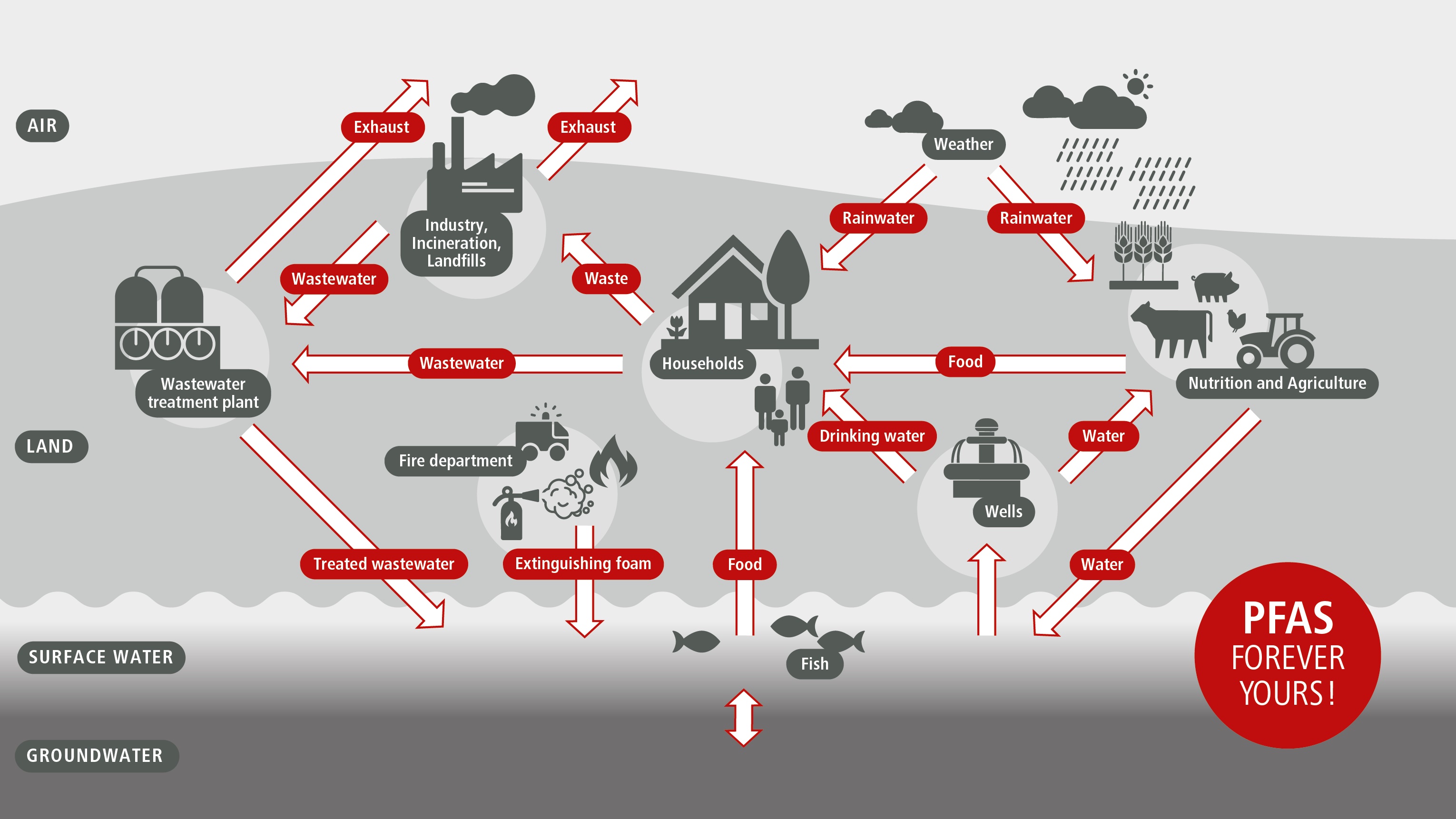Detecting PFAS in the environment
The industry uses thousands of different PFAS compounds. However, far too little is still known about the environmental impact of these substances and their degradation products. Researchers are developing reliable analytical methods to detect PFAS even in very low concentrations or with an as yet unknown chemical composition. This way, they can also investigate the path of PFAS into the food chain and into drinking water.

How do PFAS get into the environment?
PFAS accumulate in the environment and in organisms over long periods of time. But how do the substances get into the environment in the first place and how do they change and spread? Researchers at Empa and Eawag are investigating these questions.
Many PFAS are produced industrially and their production can lead to exhaust air or wastewater emissions. PFAS are released directly into the air or into nearby bodies of water. Wastewater treatment plants that treat wastewater from households and industry are currently unable to completely remove and destroy PFAS. The substances can therefore remain in the treated wastewater or in the sewage sludge. In addition, they can be dispersed further into the environment by wind and rain from the air.
In agriculture, PFAS can enter soils, crops, animal products and water through irrigation with contaminated water, through the use of sewage sludge containing PFAS or with pesticides. Although the utilization of sewage sludge for fertilizing has been banned in Switzerland since 2006, previous use of sewage sludge contaminates some agricultural areas with PFAS for many decades.
Products containing PFAS, such as food packaging or textiles, can be released into the environment during disposal and recycling. In this way, PFAS from recycled paper or cardboard can end up in products that are used for food packaging. Products containing PFAS that end up in landfills can enter the soil and groundwater via leachate.
The use of PFAS-containing fire-fighting foams in fires or on fire training grounds also contributes to the contamination of surfaces, soil and groundwater.
Challenges in PFAS analysis

Due to the longevity, widespread distribution, degradation products and risks to humans and the environment, the precise detection and characterization of PFAS is extremely important. As legal PFAS regulations are constantly being adapted, the development of new analytical methods and strategies that can detect even unknown substances and degradation products is crucial to meet future challenges and ensure accurate risk assessment.
PFAS analysis poses particular challenges as these substances are widely used in modern laboratories, which can lead to background contamination. Common sources of contamination include laboratory consumables, solvents and even personal protective equipment. Strict controls are required to ensure analytical workflows, including the use of PFAS-free materials, rigorous laboratory controls to avoid even the smallest PFAS contamination within the laboratory. In addition, PFAS analysis requires optimized extraction and purification methods to improve sensitivity.
Analytical methods for the detection and identification of known PFAS
Researchers at Empa and Eawag rely on advanced analytical techniques. These methods offer high sensitivity and selectivity. Even the smallest traces of PFAS can be detected in complex samples such as water, soil or biological fluids such as milk.
These methods include, for example:
- Liquid chromatography-tandem mass spectrometry (LC-MS/MS),
- Ultra-performance liquid chromatography-tandem mass spectrometry (UPLC-MS/MS)
- Ultra-performance liquid chromatography-high resolution mass spectrometry (UPLC-HRMS) using Orbitrap technology.
Detecting unknown PFAS (“non-target screening”)
To detect substances with yet unknown chemical composition, Empa and Eawag use non-target screening, which is crucial for the detection of unknown or emerging PFAS.
Particularly important in this respect are:
- High Resolution Mass Spectrometry (HRMS), in particular UPLC-Orbitrap-HRMS
- Data processing techniques such as suspect screening, molecular cross-linking and mass defect filtering.
Pocket Facts 02
(In)famous Allrounder:
PFAS – Forever Chemicals
Download the brochure
PFAS Analytics
Markus Zennegg
Analytical Center, Empa
Phone +41 58 765 4615
PFAS Detection in gases
Dr. Stefan Reimann
Air Pollution / Environmental Technology, Empa
Phone +41 58 765 4638
PFAS in the water cycle
Dr. Christa McArdell
Environmental Chemistry, Eawag
Phone +41 58 765 5483
PFAS Environmental analysis
Heinz Singer
Environmental Analytical Chemistry, Eawag
Phone +41 58 765 5577
PFAS water analytics
-
Share
